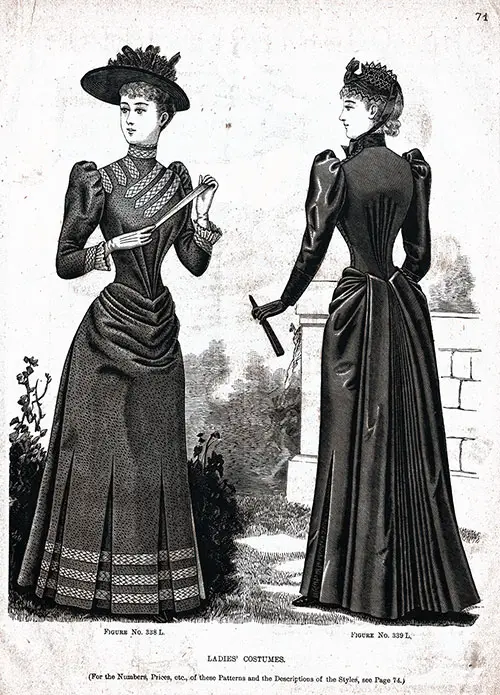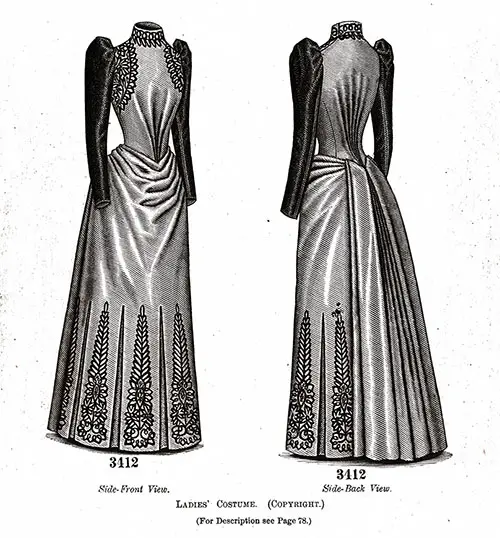Ladies Stylish Costumes 338L and 339L - 1890

Figure No. 338 L represents a front view of the costume, showing it developed in dark Cheviot, with ruffles of white lace and an effective arrangement of white basket braid for garniture. The skirt is in the received four-gored style and is only slightly revealed by the over-dress.
The body of the overdress has under-fronts, which are adjusted by double bust darts and closed at the center with hooks and eyes, and a full front, which is included in the right shoulder and underarm seams and fastened with buttons and button-holes at the corresponding seams at the left side.
The fullness below the bust is becomingly disposed in forward- turning plaits that flare upward from the well-defined point at the center. The seamless back is arranged similarly over a plain back that is fitted by side-back gores and a curving center seam, and underarm gores complete the superb adjustment.
The tablier-drapery joins the lower edges of the front and right under-front in a seam and is fastened invisibly with hooks and eyes at the left side. A cluster of upward-turning plaits is visible in each side edge closer to the top; the pleats flare toward the center and produce a series of soft curves and wrinkles across the front.
The lower edge is slashed to form deep, narrow tabs, which are trimmed with rows of white basket braid. Rows of similar braid are arranged on the skirt so that they appear to encircle the front of the costume without interruption.
The back-drapery is also joined to the body and is arranged at each side of the center in a cluster of backward-turning plaits that flare with fan effect to the edge.
A deep, forward-turning plait at each side of these produces the effect of a box-plait, and tackings secure the hemmed side edges of the drapery to the corresponding edges of the tablier.
The full sleeves are made over smooth linings and have the stylish high effect above the shoulders, and each wrist is prettily finished with a row of braid, below which a delicate frill of white lace droops toward the hand.
Rows of braid trim the front above the bust uniquely, and the standing collar, which closes at the left side, is encircled with the braid.
The black straw hat is becomingly trimmed with lace and loops of narrow ribbon.
At figure No. 339 L is given a back view of the costume, picturing it made up for mourning wear, the material being dull-black Henrietta cloth, with just a suggestion of black crape showing between the tabs and forming an appropriate finish for the neck and wrists.
Dressmaking Options
A stylish costume for formal wear may be developed in Surah silk, foulard, Bengaline, etc., either singly or in combination with velvet for the full sleeves, etc. For general wear, cashmere, Henrietta cloth, maline, foulé, camels-hair, and various other woolens will make a fancy and serviceable costume.
Various garnitures may be added, such as deep Vandyke points of braid passementerie for the tabs, or similar designs may be wrought on the dress fabric with metallic or other braids. Embroidery done in silk of contrasting colors will form an effective decoration. The toque is of black net profusely trimmed with dull jet.
Illustration and Pattern Information
Figures Nos. 338 L and 339 L.—These two figures illustrate the same pattern—Ladies’ costume No. 3412, which costs 1s. 8d. or 40 cents. The pattern is in thirteen sizes for ladies from twenty- eight to forty-six inches, bust measure, and may be seen made up and trimmed differently on page 79 of this Delineator.
Ladies’ Costume Pattern No. 3412

No. 3412.—Other materials and trimmings are shown above in this costume at figures Nos. 338 L and 339 L in this magazine.
Mouse-gray Henrietta cloth and black velvet are here combined in the costume, and black braid-passementerie band, points, and bolero ornaments supply the garniture.
The skirt is in the accepted four-gored style and may be worn over a small bustle if desired. The skirt is faced for nearly half its depth with velvet and is effectively seen between the flaring edges of the draperies.
The over-dress has under-fronts, which are adjusted by double bust darts and closed at the center with hooks and eyes, and an outside front, which is included in the right shoulder and under-arm seams and fastened at the corresponding seams at the left side with hooks and eyes.
The fullness of the outside front below the bust is disposed in two forward-turning plaits at each side of the center, the pleats flaring toward the bust and lapping to a point at the lower edge.
The full-back is seamless and is arranged over a lining that is fitted by side-back gores and a center seam. Three back- ward-turning plaits in the lower edge at each side of the center flare upward in a fan shape and are tacked at intervals underneath; and under-arm gores complete the adjustment.
The tablier-drapery is slashed at the bottom to form deep, narrow tabs, and the top is joined to the body from the right side, back-seam to the left edge of the outside front, the right under-front being included in the joining.
In each side edge of the tablier near the top is laid a cluster of upturning, overlapping plaits that flare toward the center and produce a graceful fullness over the hips.
The back-drapery is joined to the body and is arranged at each side of the center in five deep, backward turning, overlapping plaits that are well pressed in their folds and flare with fan effect to the lower edge.
In front of these plaits at each side is laid one deep, forward-turning pleat; and the side edges of the back-drapery are finished with hems and tacked to the tablier midway to the lower edge.
The full sleeves are made over coat-shaped linings and rise high across the shoulders, and the high standing collar is closed at the left side.
An elaborate garniture of braid passementerie points is applied to the tabs, a row of braid passementerie is applied to the collar and bolero ornaments of passementerie decorate the front.
Costume Options
Henrietta cloth, camels-hair, serge, foulé, tamise, and all fabrics of a clinging nature will develop attractively by the mode, and combinations of wool goods with silk or velvet will be very stylish.
Elaborate designs in braiding, embroidery or Vandyke lace may be applied for garnitures, but a plain finish will be in equally good taste. If a tailored finish be desired, the edges of the basque and draperies may be bound with silk or mohair braid.
Pattern Information
We have pattern No. 3412 in thirteen sizes for ladies from twenty-eight to forty-six inches, bust measure.
To make the costume for a lady of medium size will require four yards and three-fourths of dress goods forty inches wide, and four yards and three-eighths of velvet twenty inches wide.
Of one material, it needs eleven yards and a-half, twenty-two inches wide, or seven yards and three-eighths thirty-six inches wide, or five yards and three-fourths, forty-four inches wide.
Price of pattern, 1s. 8d. or 40 cents.
“Figures Nos. 338 L. and 339 L.—Ladies' Costume” in The Delineator: A Journal of Fashion, Culture, and Fine Arts – Midsummer Number, New York: Butterick Publishing Co., Ltd, Vol. XXXVI, No. 2, August 1890, P. 74 (For Illustrations see Page 71.).
"Ladies' Costume [No. 3412]" in The Delineator: A Journal of Fashion, Culture, and Fine Arts – Midsummer Number, New York: Butterick Publishing Co., Ltd, Vol. XXXVI, No. 2, August 1890, P. 78-79 (For Illustrations see Page 79).
Editor's Note: Some terminology used in the description of women's clothing during the 1800s and early 1900s has been changed to reflect more modern terms. For example, a women's "Toilette" -- a form of costume or outfit has an entirely different common meaning in the 21st century. Typical terms applied to "toilette" include outfit, ensemble, or costume, depending on context.
Note: We have edited this text to correct grammatical errors and improve word choice to clarify the article for today’s readers. Changes made are typically minor, and we often left passive text “as is.” Those who need to quote the article directly should verify any changes by reviewing the original material.
